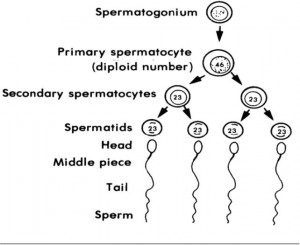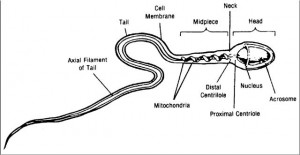a. Spermatogenesis begins during puberty and continues throughout life.
b. Millions of sperm are produced in a 24-hour period. This occurs in the seminiferous tubules (see figure 1-10).

c. The process is begun by primitive stem cells, which are called spermatogonia and are found in the outer region of each tubules. Follicle stimulating hormone is secreted by the anterior pituitary beginning at puberty. Follicle stimulating hormone is influences division of spermatogonia into primary spermatocytes.
d. Each spermatocyte undergoes meiosis and produces four spermatids. All of the male’s body cells contain the same 23 pairs of chromosomes. The spermatid contains one chromosome of each of the 23 pairs. The same chromosome configuration occurs in the ovum. When the sperm and egg unite, the normal number of chromosomes is reestablished–46 chromosomes or 23 pairs.
e. The mature sperm contains three regions: the head, which contains deoxyribonucleic acid (DNA), the midpiece, and the tail (see figure 1-11).

f. The acrosome is anterior to the head of the mature sperm. It contains special enzymes, which help the sperm to penetrate the egg.
